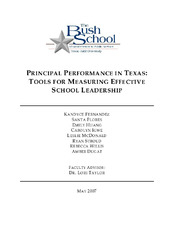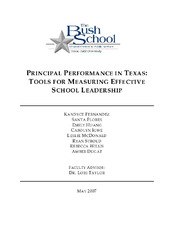| dc.description | Policymakers and superintendents have been holding teachers accountable for student performance in Texas public schools. As the interest in results and school accountability has grown, attention has shifted to the role administrators play in creating a successful educational environment. The task for this capstone was to create a set of indicators for what an effective principal might look like. The project focused on three areas: Student Performance, Teacher Retention, and Financial Management, with the understanding that an effective principal would have students who perform well on TAAS/TAKS exams, have acceptable levels of teacher turnover, and achieve these results in a financially efficient manner. Using data from the Texas Education Agency, the project developed indicators for each of these three categories so that it would have a concrete way to discuss a principal's success. After defining what it meant to say a principal is "effective," students also checked to see if a principal's influence was statistically significant controlling for other, non-principal factors such as location, demographics, and school size. Finally, the project looked at various groupings of principals in Texas in order to report on the current patterns of principal effectiveness in the state. | en |



